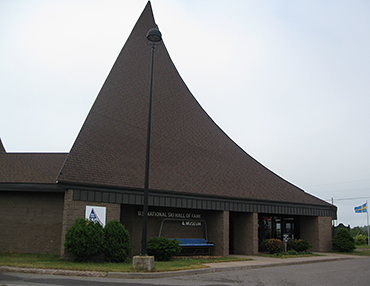 U.S. Ski and Snowboard Hall of Fame and MuseumSAM Magazine—Ishpeming, Mich., Sept. 20, 2017—Eight noted ski and snowboard athletes and sport builders form the U.S. Ski and Snowboard Hall of Fame’s Class of 2017. They are freestyle icon “Airborne” Eddie Ferguson, freestyle’s somersault king Hermann Gollner and legendary cross-country coach Marty Hall; the late, Steve McKinney, world record holder in alpine speed skiing; snowboard pioneer Shaun Palmer; ski mountaineers and twin brothers Mike and Steve Marolt; and Thom Weisel, a passionate fund raiser for the U.S. Ski Team.
U.S. Ski and Snowboard Hall of Fame and MuseumSAM Magazine—Ishpeming, Mich., Sept. 20, 2017—Eight noted ski and snowboard athletes and sport builders form the U.S. Ski and Snowboard Hall of Fame’s Class of 2017. They are freestyle icon “Airborne” Eddie Ferguson, freestyle’s somersault king Hermann Gollner and legendary cross-country coach Marty Hall; the late, Steve McKinney, world record holder in alpine speed skiing; snowboard pioneer Shaun Palmer; ski mountaineers and twin brothers Mike and Steve Marolt; and Thom Weisel, a passionate fund raiser for the U.S. Ski Team.
“Each year we are again amazed by the stories of those sport builders and athletes who have made our sport what it is today,” said Tom Kelly, chairman of the U.S. Ski and Snowboard Hall of Fame. “Honoring these inductees in the shadows of the 1960 Olympic Winter Games venues in Squaw Valley is a fitting recognition for the Class of 2017.”
The new inductees will bring the total to 435 members in the U.S. Ski and Snowboard Hall of Fame. The class, selected by a national voting panel, will be formally inducted next April in Olympic Valley, Calif. site of the 1960 Olympic Winter Games. Info and tickets will be available in October at www.SnowsportHistory.com.
The nomination process is open to all, with detailed information available at www.skihall.com.
THE CLASS OF 2017
Ed Ferguson
Known as “Airborne” Eddie Ferguson, Ferguson helped to create and grow the hotdog freestyle skier movement in the 1970s. He captured the World Freestyle Championships in 1973. With his national and international camps from 1972-79 he reached more than 4,000 students.
Hermann Gollner
A coach, competitor, and inventor, Herman Gollner was best known for performing the world’s first double backward somersault in 1965, and the first triple forward somersault in 1967. In 1968 he also completed the first full somersault with a full twist on skis, the infamous “Moebius Flip.” The long-time racing coach led the U.S. women’s alpine team during the late 1970s and invented the screw-in hinged alpine gate pole.
Marty Hall
Marty Hall was a major force in bringing U.S. cross-country skiing to the international stage. He was the first U.S. women’s national coach to support a team at FIS competition outside of the U.S. in 1970, and played a key role in coaching Bill Koch to America’s first (and only) cross-country Olympic medal in 1976 and to the World Cup title in 1982, fueled by development of skate skiing technique. In 1981 Hall published “One Stride Ahead: An Expert Guide To Cross Country Skiing.”
Michael and Steven Marolt
Identical twin brothers Mike and Steve Marolt have an impressive resume of pure-style ski descents from 5,000-8,000 meters, climbing with no supplemental oxygen, porters or altitude drugs. They have led 13 expeditions in Himalayan skiing and have climbed and skied nearly 50 of the highest and greatest peaks in the world, including first climbs and descents of the North Ridge of Everest, plus peaks in Bolivia, Peru, and South America.
Steve McKinney
The late Steve McKinney was the dominant speed skier in the world in the 1970s and ’80s, setting a world ski speed record in 1974 of 117.7 mph. After breaking his own record several times, in 1987 he went more than 130 mph and held the world speed skiing record from 1977 to 1982.
Shaun Palmer
Known as one of the forefathers of extreme sport, Shaun Palmer competed in professional snowboarding for almost 20 years. His prowess in the pipe from 1995–2014 earned him six X Games gold medals, another gold at the 2002 Gravity Games, and a berth on the 2010 Vancouver Olympic snowboardcross team before an injury took him out. He was named Action Sports Athlete of the Year at the 2001 ESPY Awards.
Thom Weisel
No other individual has had such a sustained impact on raising awareness and supporting skiing in America than Thom Weisel. Over the span of four decades, Weisel’s leadership and fundraising savvy has raised tens of millions of dollars for the U.S. Ski Team.